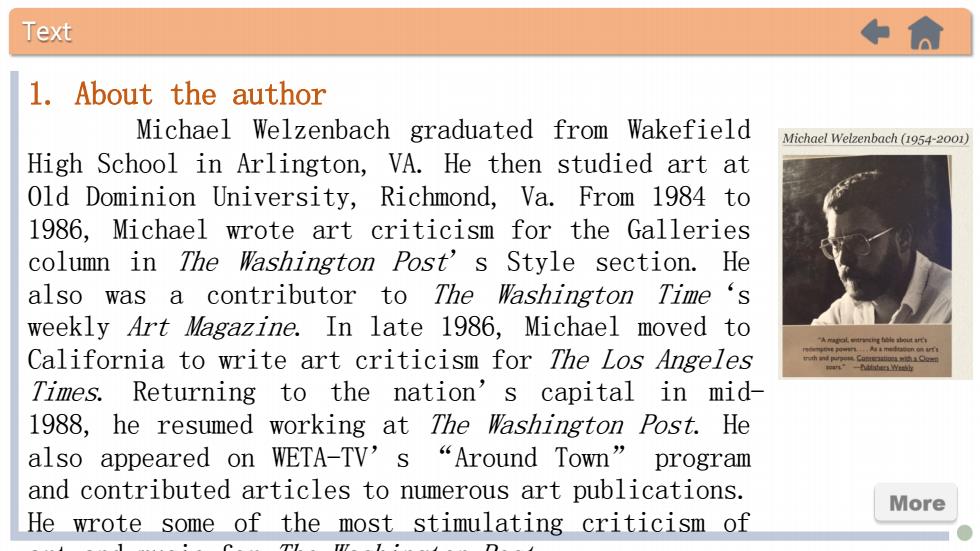
Text合l. About the authorMichael Welzenbach graduated from WakefieldMichaelWelzenbach (1954-2001)High School in Arlington, VA. He then studied art atold Dominion University, Richmond. Va. From 1984 to1986,Michael wrote artcriticism fortheGalleriescolumn in The Washington Post' s Style section. Healso was a contributor toTheWashington Time‘sweeklyArtMagazine.Inlate1986,Michael moved toCalifornia to write art criticism for The Los Angelesa0Times.Returning to the nation' s capital in mid-1988, he resumed working at The Washington Post. Healso appeared on WETA-Tv' s“Around Town”programand contributed articles to numerous art publications.MoreHe wrote some of the most stimulating criticism of
Text 1. About the author Michael Welzenbach graduated from Wakefield High School in Arlington, VA. He then studied art at Old Dominion University, Richmond, Va. From 1984 to 1986, Michael wrote art criticism for the Galleries column in The Washington Post’s Style section. He also was a contributor to The Washington Time‘s weekly Art Magazine. In late 1986, Michael moved to California to write art criticism for The Los Angeles Times. Returning to the nation’s capital in mid- 1988, he resumed working at The Washington Post. He also appeared on WETA-TV’s “Around Town” program and contributed articles to numerous art publications. He wrote some of the most stimulating criticism of art and music for The Washington Post
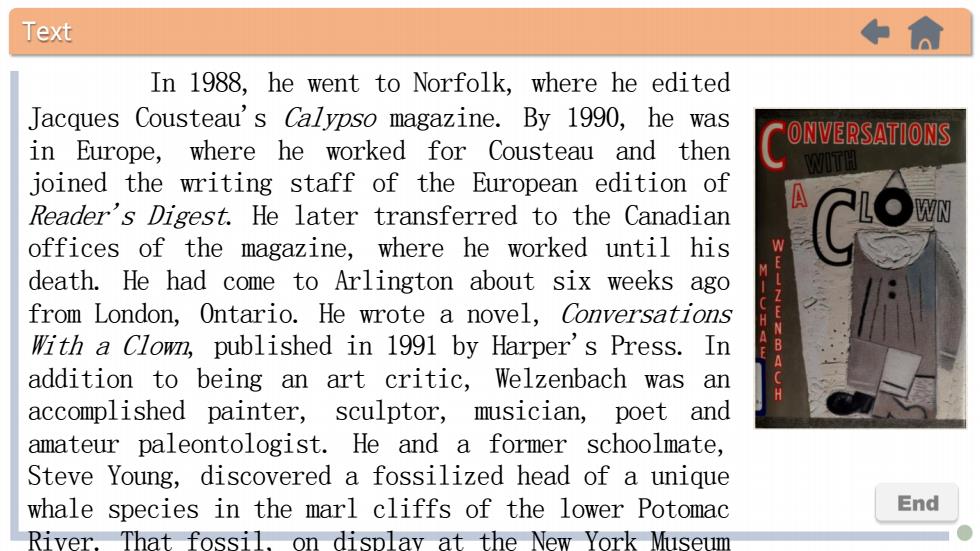
Text+食In 1988. he went to Norfolk, where he editedJacques Cousteau's Calypso magazine. By 1990, he wasONVERSATIONSCin Europe,where he worked for Cousteau and thenjoined the writing staff of the European edition ofAWNReader's Digest. He later transferred to the Canadianoffices of the magazine, where he worked until hisWdeath. He had come to Arlington about six weeks agofrom London, Ontario. He wrote a novel, ConversationsWith a Clown, published in 1991 by Harper s Press. Inaddition to being an art critic, Welzenbach was anaccomplished painter,sculptor,musician,poet andamateur paleontologist. He and a former schoolmate,Steve Young, discovered a fossilized head of a uniqueEndwhalespeciesinthemarl cliffsofthelower PotomacR1T1OY
Text In 1988, he went to Norfolk, where he edited Jacques Cousteau's Calypso magazine. By 1990, he was in Europe, where he worked for Cousteau and then joined the writing staff of the European edition of Reader's Digest. He later transferred to the Canadian offices of the magazine, where he worked until his death. He had come to Arlington about six weeks ago from London, Ontario. He wrote a novel, Conversations With a Clown, published in 1991 by Harper's Press. In addition to being an art critic, Welzenbach was an accomplished painter, sculptor, musician, poet and amateur paleontologist. He and a former schoolmate, Steve Young, discovered a fossilized head of a unique whale species in the marl cliffs of the lower Potomac River. That fossil, on display at the New York Museum of Natural History, bears his and Mr. Young’s name
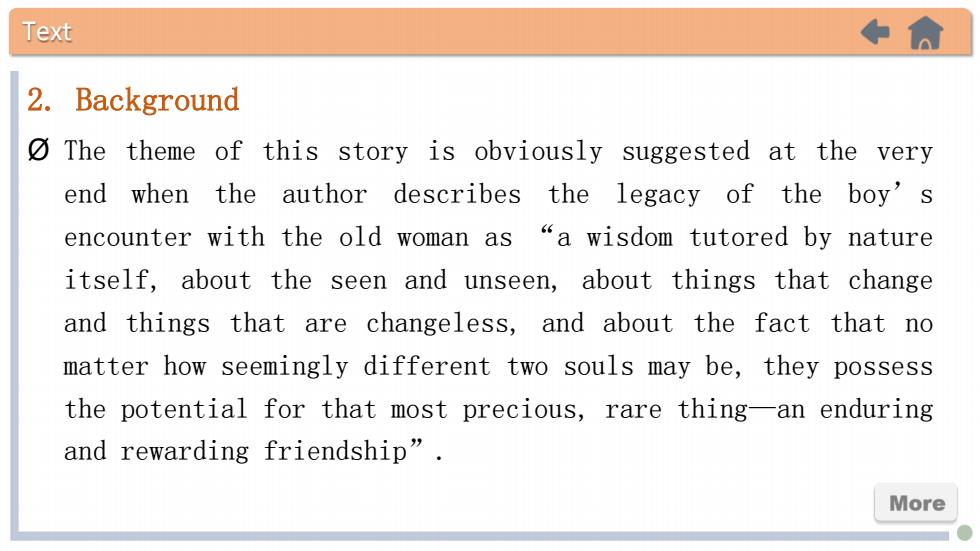
Text+食2.Background The theme of this story is obviously suggested at the veryend when the author describes the legacy of the boy' sencounter with the old woman as “a wisdom tutored by natureitself, about the seen and unseen, about things that changeand things that are changeless, and about the fact that nomatterhow seemingly differenttwo souls maybe, they possessthe potential for that most precious, rare thingan enduringand rewarding friendship”More
Text 2. Background Ø The theme of this story is obviously suggested at the very end when the author describes the legacy of the boy’s encounter with the old woman as “a wisdom tutored by nature itself, about the seen and unseen, about things that change and things that are changeless, and about the fact that no matter how seemingly different two souls may be, they possess the potential for that most precious, rare thing—an enduring and rewarding friendship
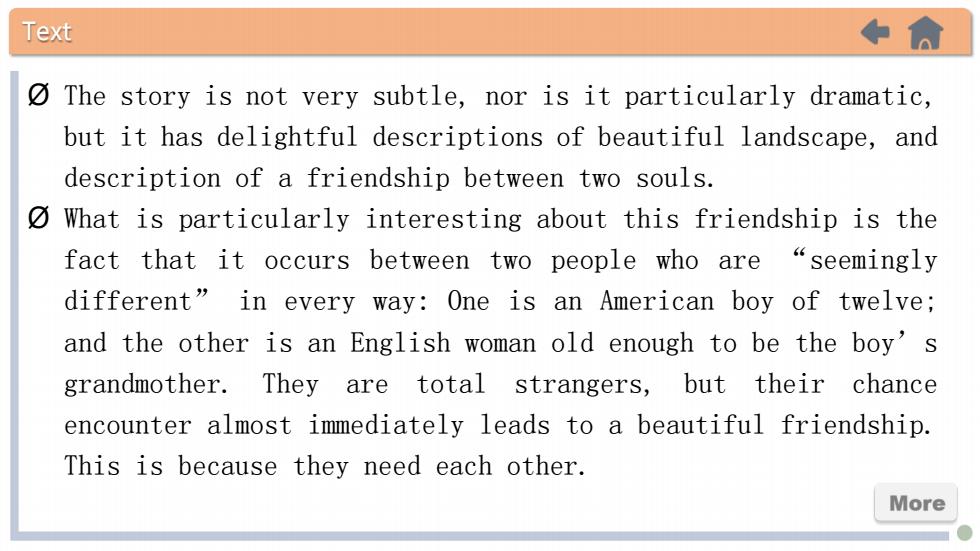
Text+食 The story is not very subtle, nor is it particularly dramatic,but it has delightful descriptions of beautiful landscape, anddescription of a friendship between two souls. What is particularly interesting about this friendship is thefact that it occurs between two people who are“seemingly?different”in every way:One is an American boy of twelve;and the other is an English woman old enough to be the boy' sgrandmother. They are total strangers, but their chanceencounter almost immediately leads to a beautiful friendshipThis is because they need each other.More
Text Ø The story is not very subtle, nor is it particularly dramatic, but it has delightful descriptions of beautiful landscape, and description of a friendship between two souls. Ø What is particularly interesting about this friendship is the fact that it occurs between two people who are “seemingly different” in every way: One is an American boy of twelve; and the other is an English woman old enough to be the boy’s grandmother. They are total strangers, but their chance encounter almost immediately leads to a beautiful friendship. This is because they need each other
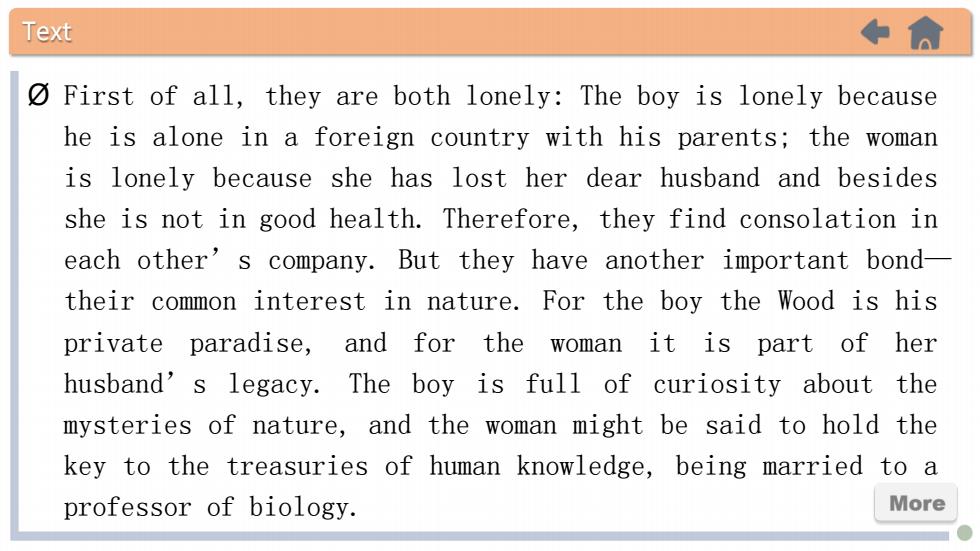
Text食Q First of all, they are both lonely: The boy is lonely becausehe is alone in a foreign country with his parents: the womanis lonely because she has lost her dear husband and besidesshe is not in good health. Therefore, they find consolation ineach other' s company. But they have another important bond-their commoninterestin nature.Fortheboythe Wood is hisprivate paradise, and for the woman it is part of herhusband' s legacy.The boy is full of curiosity about themysteries of nature, and the woman might be said to hold thekey to the treasuries of human knowledge, being married to aMoreprofessor of biology
Text Ø First of all, they are both lonely: The boy is lonely because he is alone in a foreign country with his parents; the woman is lonely because she has lost her dear husband and besides she is not in good health. Therefore, they find consolation in each other’s company. But they have another important bond— their common interest in nature. For the boy the Wood is his private paradise, and for the woman it is part of her husband’s legacy. The boy is full of curiosity about the mysteries of nature, and the woman might be said to hold the key to the treasuries of human knowledge, being married to a professor of biology